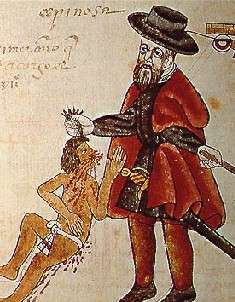Codex Kingsborough
The Codex Kingsborough, also known as the Codex Tepetlaoztoc, is a 16th-century Mesoamerican pictorial manuscript, detailing the history of Tepetlaoztoc and the abuse of the encomenderos who took control after the Spanish conquest of Mexico. It is currently in the collections of the British Museum.
| Codex Kingsborough | |
|---|---|
 | |
| Material | Paper |
| Size | 29.5 cm x 21.5 cm |
| Created | c. 1550s |
| Place | Tepetlaoztoc, Mexico |
| Present location | British Museum, London |
| Identification | Am2006,Drg.13964 |
| Registration | Am2006 |
History
The manuscript was commissioned after the Spanish colonization of the Americas had begun, by the inhabitants of Tepetlaoztoc and its indigenous governor, Luis de Tepada.[1] It was part of a lawsuit brought by Tepetlaoztoc's inhabitants against the Spanish encomenderos, complaining about the mistreatment of the indigenous population, and was probably presented to the Council of the Indies. It consists of seventy-two leaves on European paper, six of which are blank.[1]
It was made circa 1550s, and at some point came into the possession of the antiquarian and scholar of Mesoamerica Edward King, Viscount Kingsborough, after whom the codex is commonly known. It was sold after his death, being bought by a bookseller named Rodd in 1843, and later acquired by the British Museum.[1]
References
- Valle Pérez, Perla (1993). Memorial de los indios de Tepetlaoztoc o Códice Kingsborough, a cuatrocientos cuarenta años (in Spanish). Mexico City: Instituto Nacional de Antropología e Historia.